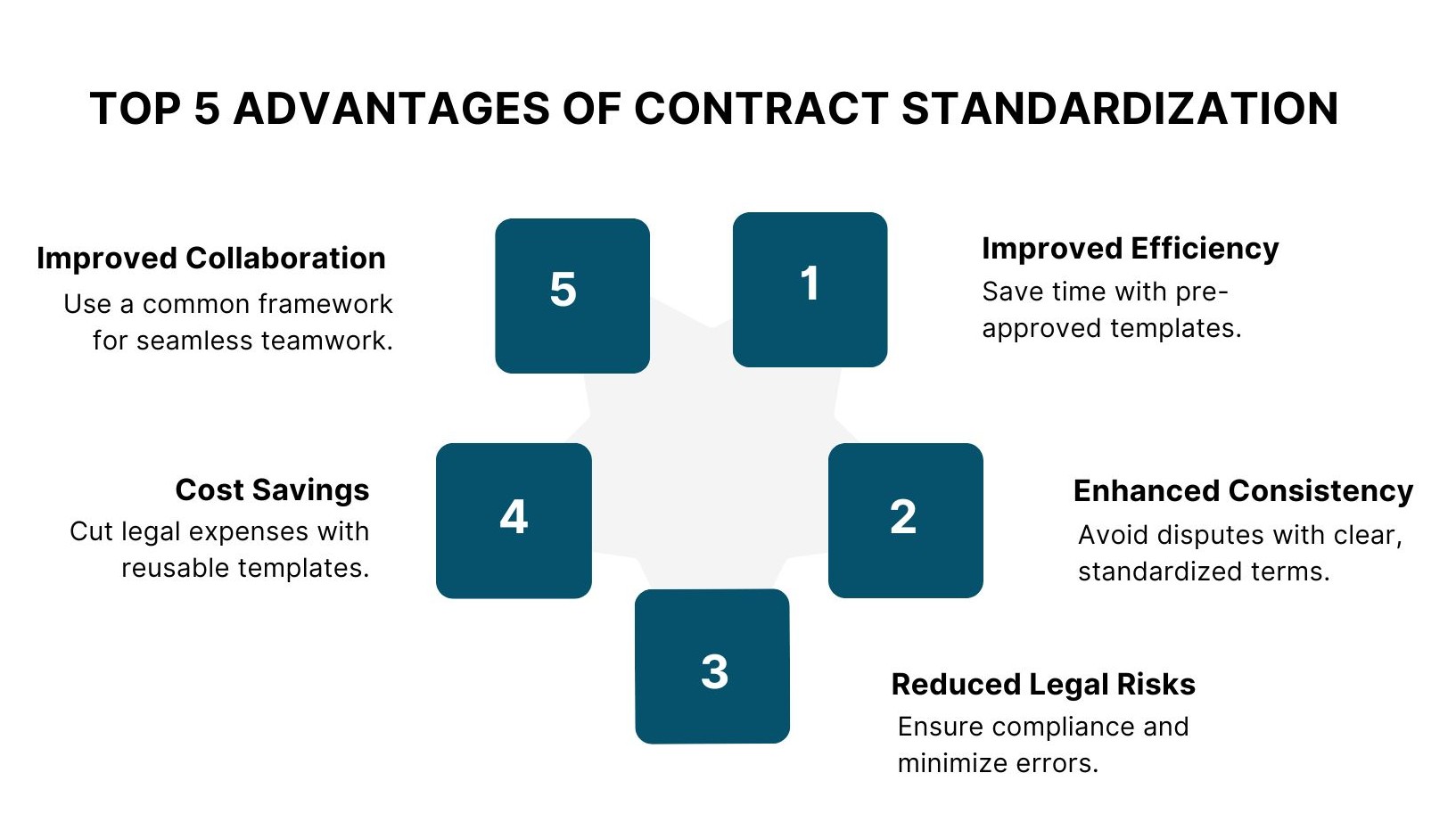Today’s competitive business environment relies on efficiency and clarity. Contract standardization is one way to achieve both. This means creating standardized templates and procedures applicable to different transactions, industries, and jurisdictions. Adopting contract standardization allows a business to streamline processes, minimize risk, and increase collaboration. In this article, we will review the advantages of contract standardization, these considerations for effective implementation, and why it’s a game-changer for modern transactions.
What is Contract Standardization?
At its core, Contract Standardization is the process of developing consistent, reusable contract templates that outline the terms and conditions of agreements. These templates are designed to be adaptable to different scenarios while maintaining a uniform structure. For example, a standardized contract for vendor agreements might include sections on payment terms, delivery schedules, and dispute resolution, all formatted in a way that’s easy to understand and modify.
The concept of Contract Standardization isn’t new, but its importance has grown significantly in recent years. As businesses expand globally and deal with increasingly complex regulations, having a standardized approach to contracts ensures that all parties are on the same page. This reduces misunderstandings, minimizes legal risks, and speeds up the negotiation process.
The Benefits of Contract Standardization
Contract Standardization is a game-changer for businesses of all sizes. It simplifies the contract process, improves consistency, reduces legal risks, and cuts costs. By using pre-approved templates, companies can streamline their operations and focus on growth instead of spending unnecessary time on drafting custom contracts. Here are five key benefits of contract standardization:

1. Improved Efficiency
One of the most immediate benefits of Contract Standardization is the time saved during the contract creation process. Instead of drafting a new contract from scratch for every deal, businesses can use pre-approved templates. This not only speeds up the process but also ensures that all necessary clauses are included.
For example, a company that frequently enters into non-disclosure agreements (NDAs) can create a standardized NDA template. This template can be reused across multiple deals, with only minor adjustments needed for specific circumstances. This approach eliminates redundant work and allows legal teams to focus on more complex tasks.
2. Enhanced Consistency
Consistency is key in any business relationship. Contract Standardization ensures that all contracts follow the same format and include the same essential terms. This consistency reduces the likelihood of disputes arising from ambiguous language or missing clauses.
Consider a scenario where a company uses different contract formats for similar deals. One contract might include a detailed force majeure clause, while another omits it entirely. This inconsistency could lead to confusion and legal challenges if unforeseen events occur. By standardizing contracts, businesses can avoid such pitfalls and maintain clear, consistent agreements.
3. Reduced Legal Risks
Legal risks are a major concern for businesses, especially when dealing with contracts. Contract Standardization helps mitigate these risks by ensuring that all contracts comply with relevant laws and regulations. Standardized contracts are typically reviewed and approved by legal experts, reducing the chances of errors or omissions.
For instance, a standardized employment contract can include all the necessary provisions to comply with labor laws, such as overtime pay, leave policies, and termination procedures. This not only protects the employer but also ensures that employees are treated fairly and consistently.
4. Cost Savings
Drafting custom contracts for every deal can be expensive, especially when legal fees are involved. Contract Standardization reduces these costs by minimizing the need for extensive legal review. Once a template is approved, it can be reused multiple times, saving both time and money.
Additionally, standardized contracts can help businesses avoid costly disputes. By clearly outlining the terms and conditions, these contracts reduce the likelihood of misunderstandings and litigation. This translates to significant cost savings in the long run.
5. Improved Collaboration
In today’s interconnected world, businesses often collaborate with partners, suppliers, and clients across different regions. Contract Standardization facilitates this collaboration by providing a common framework for agreements. When all parties are familiar with the contract format, negotiations become smoother and more efficient.
For example, a multinational corporation can use standardized contracts for its global supply chain. This ensures that all suppliers adhere to the same terms and conditions, regardless of their location. This uniformity fosters trust and strengthens business relationships.
How to Implement Contract Standardization
1. Identify Common Contract Types: The first step in implementing Contract Standardization is to identify the types of contracts your business uses most frequently. These might include sales agreements, service contracts, NDAs, employment agreements, and more. Once you’ve identified these contracts, you can begin developing standardized templates.
2. Involve Key Stakeholders: Contract Standardization is a collaborative process that requires input from various stakeholders, including legal teams, procurement departments, and business leaders. By involving these stakeholders early on, you can ensure that the standardized contracts meet the needs of all parties.
3. Develop Clear Templates: The next step is to develop clear, concise templates for each type of contract. These templates should include all the essential terms and conditions, with placeholders for specific details. For example, a sales agreement template might include sections for pricing, delivery terms, and warranties, with blank fields for the buyer’s and seller’s information.
4. Train Your Team: Once the templates are ready, it’s important to train your team on how to use them effectively. This includes providing guidance on when to use each template, how to fill in the details, and when to seek legal advice. Proper training ensures that everyone is on the same page and reduces the risk of errors.
5. Monitor and Update: Contract Standardization is not a one-time process. As your business evolves and new regulations emerge, it’s important to review and update your templates regularly. This ensures that your contracts remain compliant and relevant.
Real-World Examples of Contract Standardization
1. The Tech Industry
The tech industry is a prime example of Contract Standardization in action. Companies like Microsoft and Google use standardized contracts for software licensing, cloud services, and partnerships. These contracts are designed to be scalable and adaptable, allowing the companies to quickly onboard new clients and partners.
2. Healthcare
In the healthcare industry, Contract Standardization is used to streamline agreements between hospitals, insurers, and suppliers. Standardized contracts ensure that all parties adhere to the same terms, reducing administrative burdens and improving patient care.
3. Construction
The construction industry relies heavily on Contract Standardization to manage complex projects. Standardized contracts for construction agreements, subcontractor agreements, and procurement contracts help ensure that all parties are aligned and that projects are completed on time and within budget.
Challenges of Contract Standardization
While Contract Standardization offers numerous benefits, it’s not without its challenges. One of the main challenges is balancing standardization with flexibility. While standardized contracts provide consistency, they must also be adaptable to unique circumstances. For example, a standardized contract for a small business might not be suitable for a large corporation.
Another challenge is ensuring compliance with local laws and regulations. In the United States, for instance, contract laws can vary from state to state. Businesses must ensure that their standardized contracts comply with all relevant laws, which may require customization for different jurisdictions.
Read More: How to Draft a Simple Contract
Conclusion
Contract Standardization is a powerful tool for modern businesses. By creating uniform contract templates and processes, companies can improve efficiency, reduce risks, and enhance collaboration. Whether you’re a small business or a multinational corporation, implementing Contract Standardization can help you stay competitive in today’s dynamic market.
As you embark on your journey toward Contract Standardization, remember to involve key stakeholders, develop clear templates, and provide proper training. By doing so, you’ll unlock the full potential of Contract Standardization and set your business up for success.
In a world where time is money and clarity is king, Contract Standardization is more than just a best practice—it’s a necessity. So, take the first step today and experience the transformative power of Contract Standardization in your deals.
Did you find this article worthwhile? More engaging blogs and products about smart contracts on the blockchain, contract management software, and electronic signatures can be found in the Legitt AI. You may also contact Legitt to hire the best contract lifecycle management services and solutions, along with free contract templates.
FAQs on Contract Standardization
What is Contract Standardization?
Contract Standardization is the process of creating uniform, reusable contract templates that outline the essential terms and conditions of agreements. It helps businesses streamline operations, reduce risks, and enhance collaboration across various transactions, industries, and jurisdictions.
How does Contract Standardization improve efficiency?
By using pre-approved contract templates, businesses save time by avoiding the need to draft new contracts for every deal. This speeds up the process, ensures essential clauses are included, and allows legal teams to focus on more complex tasks.
What are the benefits of Contract Standardization?
Some of the key benefits include improved efficiency, enhanced consistency, reduced legal risks, cost savings, and better collaboration across departments and with external partners.
How does Contract Standardization reduce legal risks?
Standardized contracts are typically reviewed and approved by legal experts, ensuring compliance with relevant laws and regulations. This reduces the chances of errors, omissions, or disputes, protecting the business from legal challenges.
Can Contract Standardization save money?
Yes, by minimizing the need for custom contracts and reducing legal review time, Contract Standardization can result in significant cost savings. It also reduces the likelihood of costly disputes by providing clear, consistent agreements.
What types of contracts should be standardized?
Businesses should prioritize standardizing contracts that are used frequently, such as sales agreements, service contracts, NDAs, and employment agreements. These contracts can then be reused and easily adapted for specific transactions.
How do I implement Contract Standardization in my business?
Start by identifying common contract types, involving key stakeholders in the process, developing clear templates, training your team on how to use them, and regularly reviewing and updating the templates to remain compliant with changing regulations.
What are the challenges of Contract Standardization?
Challenges include balancing standardization with the flexibility to adapt to unique circumstances and ensuring compliance with local laws and regulations, which can vary by jurisdiction.
How does Contract Standardization improve collaboration?
It provides a common framework for all parties involved, making negotiations smoother and faster. It ensures that everyone is familiar with the format and terms, building trust and strengthening business relationships.
Can Contract Standardization be used in all industries?
Yes, Contract Standardization is beneficial across various industries, including tech, healthcare, and construction, where it streamlines processes, ensures compliance, and reduces administrative burdens. Each industry may have its own specific templates, but the core benefits remain the same.
